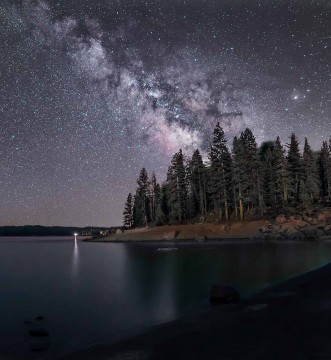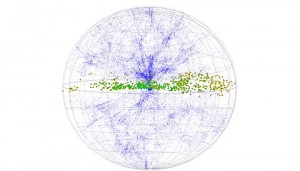Astronomers have detected hundreds of galaxies lying hidden behind our galaxy's disk, many of which belong to the so-called Great Attractor.

S&T Gallery / [email protected]
The Milky Way lives in a cosmic watershed. Instead of streams of water forming the tributaries, galaxies and galaxy clusters do. These “drain” down into valleys, networks of clusters and superclusters of humongous proportions.
Astronomers have been mapping out this watershed for decades, with much success. But there are still some unexplored corners. These generally lie along the zone of avoidance, the strip of sky covered by our spiral galaxy’s disk. The Milky Way may be beautiful, but for astronomers wanting to explore beyond it, it’s a pain in the neck.
To peer through the galactic plane, astronomers often observe neutral hydrogen, designated HI. Specifically, they observe 21-centimeter radio waves, which are produced when the electron in a hydrogen atom does a quantum cartwheel and flips to spin in the opposite direction of the atom’s proton.
There are two perks to observing distant galaxies at this wavelength. One, radio wavelengths aren’t hindered by the Milky Way’s dust, so 21-cm emission can pass through the interstellar muck lying between us and distant objects. Two, astronomers estimate a galaxy’s distance based on how fast it’s moving away from us, which they calculate from how much the galaxy’s spectral lines have shifted from their rest wavelengths. So any shift in the 21-cm line’s wavelength also immediately tells astronomers how far away the object they’re observing is.

ICRAR
An ongoing mapping project, called HIZOA, has surveyed most of the zone of avoidance that’s visible from the Northern Hemisphere. Reporting in the March Astronomical Journal, Lister Staveley-Smith (University of Western Australia) and colleagues have now released their analysis of the entire Southern Hemisphere ZOA, or HIZOA-S.
The survey covers more than 1800 square degrees, homing in on the narrow stripe drawn by the galactic plane and staring through it, much as we ignore dust when looking through a windshield. The survey probes out to about 250 million light-years, on the scale of our home supercluster, Laniakea. It turned up 883 galaxies, one-third of which had never been catalogued, and less than 10% of which had ever had their distances measured.
Combined with the northern data, HIZOA has detected 957 galaxies. There are no big surprises; rather, these observations reveal new details about our local cosmic structure. For example, Staveley-Smith’s team found new extensions to the Norma Supercluster, also known as the Norma Wall or the Great Attractor. The Great Attractor is the major valley in our cosmic watershed, toward which the Milky Way and many of our neighbors are being pulled by gravity. The wall centers on the massive Norma Cluster, ACO 3627, and the new data show that the wall stretches roughly 50 degrees across the sky. At a distance of about 200 million light-years, that means it’s something like 250 million light-years long. (And that doesn’t include the “weak extension” the survey turned up.)
The team also uncovered a possible second wall and several groups and galaxy concentrations, including a group in the constellation Monoceros, as well as a potential companion to the active Circinus galaxy.
Below, you’ll find a video animation of the galaxies in our neighborhood, including those previously detected (in blue) and those from HIZOA (other colors). Each dot represents a galaxy. At center (the big blue dot) is Earth, and the plane of the Milky Way’s disk is the equator of the sphere. As you can see, the HIZOA galaxies fill in the space blocked by the galactic plane. The scale is roughly half as large as the Laniakea map in my blog from 2014. Credit: ICRAR.
Reference: L. Staveley-Smith et al. "The Parkes HI Zone of Avoidance Survey." Astronomical Journal. March 2016.
Navigate your way across the sky with our Jumbo Pocket Sky Atlas.
 2
2
Comments
Tom Hoffelder
February 10, 2016 at 9:06 am
Thank you thank you thank you! For noting how those Milky Way "photographs" are created! Unfortunately, most of the readers of skyandtelescope.com already know. All those slightly less scientific websites posting Milky Way photographs should do the same, which of course is most unlikely.
You must be logged in to post a comment.
Anthony Barreiro
February 10, 2016 at 6:06 pm
Thanks very much for this clear and interesting report. The discovery of about 300 galaxies within 250 million light years of us seems quite remarkable. And thanks also for using the word "humongous" in the introductory paragraph -- that puts things in perspective!
You must be logged in to post a comment.
You must be logged in to post a comment.